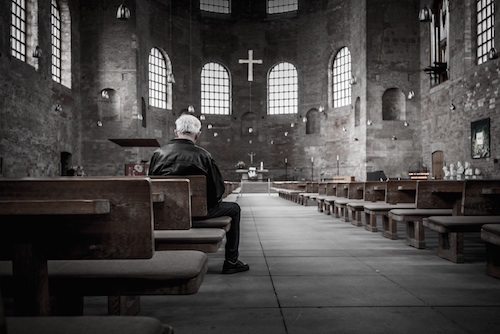We run our website the way we wished the whole internet worked: we provide high quality original content with no ads. We are funded solely by your direct support. Please consider supporting this project.

The Cruciform Trinity
As paradoxical as it sounds, if God is supremely revealed when he stoops to the infinite extremity of becoming his own antithesis on the cross, then we must conclude that stooping to this extremity out of love must, in some sense, be intrinsic to who God eternally is. And rendering this coherent necessitates that we understand God’s revelation on the cross in Trinitarian terms.
The orthodox doctrine of the Trinity states that from all eternity, and apart from any relationship with others outside himself, God’s exists as three Divine Persons who fully pour themselves out for one another and who fully dwell within one another in perfect love. In my opinion, this pouring out and mutual indwelling was best expressed in the Cappadocion doctrine of the “perichoresis” of the three Persons and, with von Balthazar and Moltmann, I understand the eternal act of each divine Person completely giving themselves to the others in love to entail a sort of self-emptying (kenosis) in the very essence of God. (See J. Moltmann, The Trinity and the Kingdom: The Doctrine of God, 58-60, 118-9; von Balthasar, Love Alone, 86-9.) Indeed, if the self-emptying of God to become a human and to die on the cross (Phil 2:6) reveals God’s eternal nature, there must be something corresponding to this self-emptying within the eternal Godhead.
This means that, when the Son emptied himself to identify fully with our limited humanity, our sin, and our God-forsakeness, he was not doing something that was alien to God’s eternal nature. Rather, as Bauckham puts it, “[i]n this act of self-giving God is most truly himself and defines himself for the world.” The perfect, humble, other-oriented love that is displayed in the self-emptying of the Incarnation and Crucifixion, considered as one revelatory act, reveals God precisely because it reflects what God is like within himself and throughout eternity. Torrance argues that, “the atoning act perfected in the cross of Jesus Christ is grounded in the very being of the eternal God, that is, in the eternal being of the Holy Trinity.”
We can, in fact, take this a step further by noting that, in pouring himself out to the point of experiencing his own antithesis, God was not only not doing something that was not alien to himself: he was rather enveloping humans into the same pouring out and mutual indwelling of the three divine Persons that constitutes his eternal essence. And this incorporation is how God makes his eternal nature known to us and how he thereby saves us. We are not only made beneficiaries of God’s self-giving love; we are made “participants of the divine nature” (2 Pet 1:4). By being placed “in Christ” (e.g., Eph 1:3-9) we are by grace becoming participants in the loving oneness of the Father and Son (Jn 17:21-3). Hence, in Christ we are loved by the Father with the same perfect love the Father has for his Son (Jn 17:26; Eph 1:6) and (what comes to the same thing) we are given the same “glory” the Father gives to Jesus (Jn 17:24).
When the Son stooped to the infinite extremity of identifying with our sin and experiencing our God-forsakenness, he was manifesting, and incorporating us into, the perfect, loving holiness and unity that he eternally enjoys with the Father and Spirit. He became our wrong-relatedness to God (sin) in order to incorporate us into his eternal right-relatedness with God (righteousness, 2 Cor 5:21). Hence, we must conclude that the triune God reveals who he truly is, and allows humans to participate in who he truly is, precisely when God, out of love, stoops to becoming his own antithesis. And this is why God’s unsurpassable accommodation of our limitations and sin on Calvary constitutes the ultimate revelation of the triune God. The Trinity is thus not only the presupposition of the intelligibility of God’s revelation on the cross; it is also the content of what is revealed and shared with us on the cross.
Image by Stefan Kunze
Category: General
Tags: Character of God, Crucifixion, Jesus, Kenosis, Love, Trinity
Topics: Trinity
Related Reading

Yahweh as the Dark Knight
I recently received an interesting analogy for The Crucifixion of the Warrior God from Aaron Reini. Thank you Aaron! In the final scene of “The Dark Knight,” Batman and Commissioner Gordon are standing over Harvey Dent, whom everyone in Gotham City looks up to as a hero, but whom the Joker had turned into a…

Sermon Clip: Keeping Christmas
Through Christ, God fulfills all his promises, and by yielding to him and giving up control, we can set ourselves free. Full Sermon here: http://whchurch.org/sermons-media/sermon/keeping-christmas

Is Having the “Right” Theology the Core of Christianity?
Last week, we posted a piece by Greg that challenges the practice being violent “in the name of Jesus” toward others who err theologically. (Click here to read this post.) Being that this piece got a lot of attention, we thought it worthwhile to provide some further explication to this point, especially in the light…

Why the Rapture is a Bad Idea
Is the Rapture really what you think it is? Most Christians believe that God will take his followers up to heaven before the really bad stuff starts on earth, but is this what the bible says? Is this view consistent with the loving God that Jesus shows us in the New Testament? View the full…

Overemphasizing Christ?
In response to my work, some have argued that I tend to overemphasize Christ. In light of the claim that in Jesus we have the one and only definitive Word of God and that no previous revelation should ever be placed alongside him or allowed to qualify what he reveals about God, some allege that…

What About the Contradictions Found in the Gospels?
It’s quite common for people to question the veracity of the Gospels because there are contradictions between them. In fact, an interaction between Steven Colbert and Bart Erhman, a scholar who makes a big deal of these contradictions, has become quite popular. While Colbert’s comedic response is entertaining, we must say more. And Greg has done…
